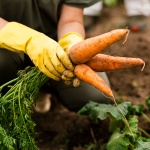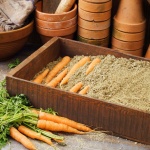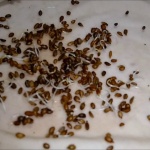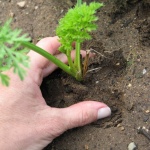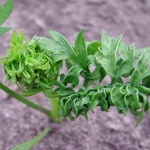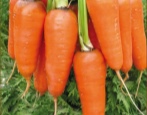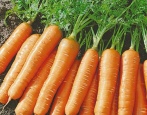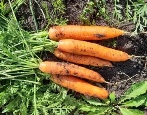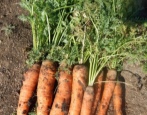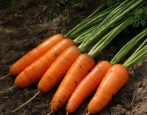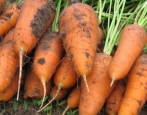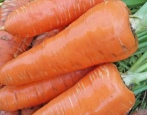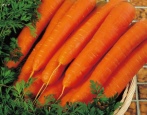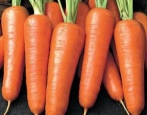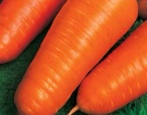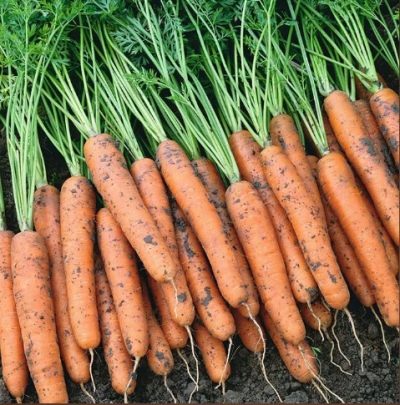
- Authors: Holland
- Name synonyms: Napoli
- Year of approval: 1993
- Appointment: for fresh consumption, for bundled products
- Leaf rosette shape: upright
- Leaves: medium, light green to dark green, strongly split
- Weight, g: 66-154
- The form : cylindrical with blunt tip
- Taste qualities: good ones
- Ripening terms: early
Carrots are a welcome guest on any garden ridge, the main thing is to choose a variety or hybrid that will not only look attractive, but also very tasty, adapt well to growing conditions, and also bring good yields. These characteristics are endowed with an early maturing hybrid of Napoli of the Dutch selection.
Breeding history
Napoli is a hybrid of the first generation, created more than 30 years ago by Dutch breeders of the Bejo Zaden B. V. In 1993, the vegetable crop was entered into the State Register of Approved Use. The vegetable is cultivated both in small garden beds and in farm fields. Recommended for growing a hybrid for nine regions - from Central to East Siberian.
Description of the variety
The Dutch vegetable is a plant with a strong and thickened rosette, of a shortened length. Erect leaves are light green in color and strongly split edges. The tops have no pronounced aroma. Napoli belongs to the Nantes cultivar.
When ripe, the root crop protrudes slightly above the soil surface, so harvesting is easy and convenient.
Characteristics of the appearance of the plant and root crops
Napoli represents a group of medium-fruited varieties. Vegetables are ripened even and tidy. The average weight of root crops is 66-154 grams. The length of carrots does not exceed 19-21 cm, and the diameter is 3-4 cm. A ripe vegetable is evenly colored orange or light orange. The shape of the fruit is correct - cylindrical with a blunt "nose". The bark of the root vegetable is thin, smooth, with a barely noticeable shine and a small number of filamentous roots. There are practically no bumps and other imperfections on the surface.
The dug or harvested crop is easy to transport. The shelf life of the hybrid is short, since the carrots are early, so vegetables are recommended to be used or processed in a short time.
Purpose and taste of tubers
Napoli is remembered for its excellent taste. The orange pulp is characterized by a firm, tender, crunchy and juicy consistency without fiber and bitterness. The core of the vegetable is thin, does not differ at all in color from the pulp. The taste is dominated by pleasant sweetness, which is complemented by a carrot aroma. The calorie content of carrots ranges from 30-35 kcal. Carrot pulp is rich in micro- and macroelements, as well as vitamins - E, A, C, K, B1, B2, N.
The harvested crop can be eaten fresh, added to cold and hot dishes, pickled, frozen, used for canning, and the hybrid is also suitable for bunch products.
Maturation
The Dutch hybrid belongs to the early maturing. From mass germination to full ripening of root crops, 90-100 days pass. The ripening of root crops and the return of the harvest are friendly. You can selectively pull out carrots in the second half of July. The massive harvest takes place in August-September.
Yield
Subject to the basic rules of agricultural technology, up to 5.6 kg of juicy specimens can be collected from 1 m2 of plantings. Growing a crop for commercial purposes, an average of 224-561 centners of root crops are dug out from 1 hectare of plantations.
Growing and care
Early carrots are cultivated by the seed method. Before sowing, a site is carefully prepared, on which elongated grooves are made with a depth of 1-2 cm.The distance between the rows is 15-20 cm.Carrots are planted according to the scheme 5-7 by 15-20 cm.
Sowing of seeds is carried out in late April - early May, when the air and soil temperature has stabilized, and return spring frosts are left behind. The best location is where cucumbers, tomatoes, onions or early potatoes were previously grown.
Podzimny sowing of carrots is carried out in mid-October.
The agricultural technology of vegetable crops consists of standard measures: watering with settled water every 4-5 days, applying fertilizers 3-4 times per season (carrots prefer mineral fertilizing), loosening and weeding, thinning, keeping a distance between plants of 6-7 cm (two times is enough ), prevention of viruses and pests.
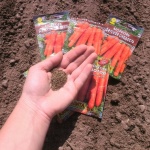
Carrots are one of the most unpretentious crops in terms of growing conditions; they can endure a short drought and a short cold snap. However, to get tasty and large root crops, you should adhere to the basic rules for planting carrots.

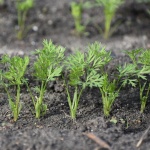
Soil requirements
Dutch carrots prefer light, loose and moist soils with good air permeability. It is optimal to properly plant the culture in light and nutritious loams or sandy loams with a high humus content.
Required climatic conditions
For growing carrots, a sunny, leveled or low-rise area where there is enough light and warmth is chosen. The plant does not like waterloggedness and excessive dampness. In addition, the Napoli hybrid is susceptible to prolonged shade and sudden temperature changes.
Disease and pest resistance
The carrot variety has good immunity, therefore, if basic care is followed, carrots rarely get sick. A feature of the hybrid is resistance to carrot fly attacks. To avoid the invasion of parasites, it is recommended to alternate carrot beds with onions.
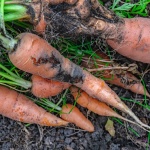
Carrots grow in almost any garden. There is an opinion that this culture is very resistant to all kinds of diseases and pests, but this is not the case. Without proper care, carrots become susceptible to all kinds of infections and are affected by harmful insects.
